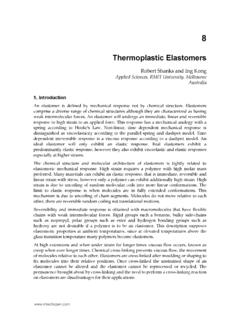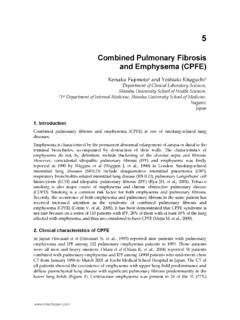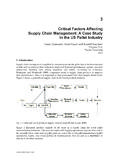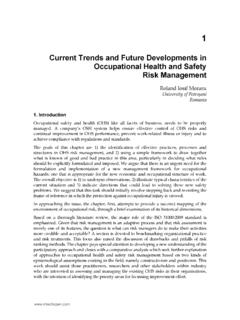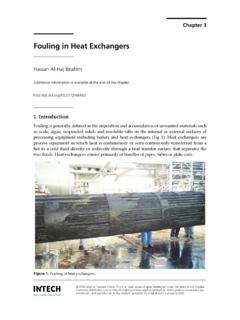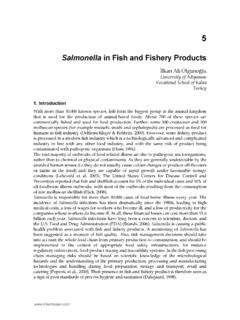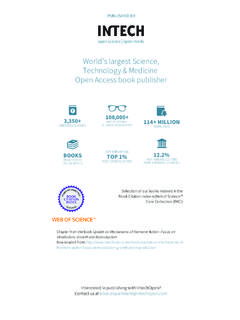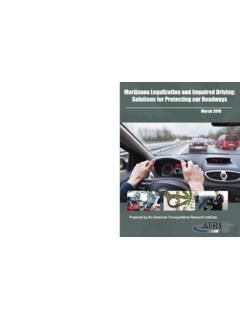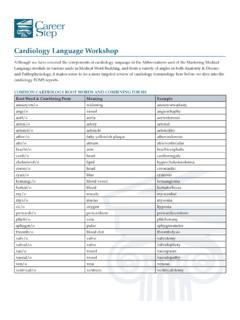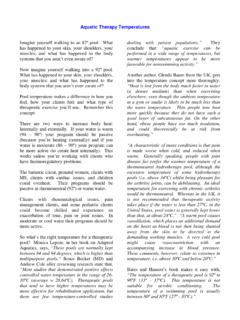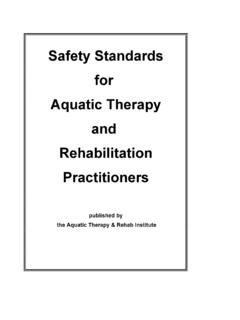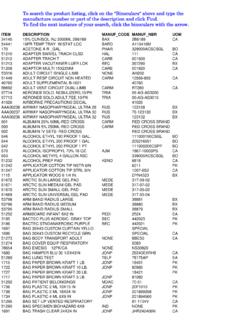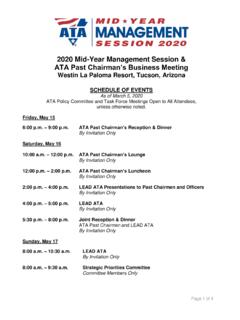Transcription of Different Automatic Mode Switching in DDDR Pacemakers
1 2. Different Automatic Mode Switching in DDDR Pacemakers Maurizio Santomauro MD1, Carlo Duilio MD1, Carla Riganti MD1, Paolo Di Mauro MD1, Gennaro Iapicca MD1, Luca Auricchio Eng2, Alessio Borrelli MD3 and Pasquale Perrone Filardi MD1. 1 Department of Medicine, Cardiology and Immunology. Federico II School of Medicine University of Naples, Naples 2 Boston Scientific, CRM Department, Milan, 3 Department of Cardiology, Humanitas Hospital, Bergamo, Italy 1. Introduction Mode- Switching algorithms are designed to alleviate symptoms related to tracking of atrial arrhythmias, that may result in inappropriately rapid or irregular ventricular pacing[1 19]. The ideal mode- Switching algorithm should discriminate sinus tachycardia, a rhythm that should be tracked, from pathological atrial arrhythmias, rhythms that generally should not be tracked.
2 In order to minimize symptoms related to the occurrence of atrial arrhythmias, the mode- Switching algorithm should change quickly from a tracking to a non-tracking mode at the onset of the pathological atrial rhythm and remains in this mode until the arrhythmia terminates. Once sinus rhythm has been restored, the pacemaker should revert quickly to the normal atrial tracking mode. There are several potential causes of symptoms that relate to mode Switching . First, an irregular paced ventricular intervals at the onset of an atrial arrhythmia before conversion to a non-tracking mode. Second, failure of the device to convert to a non-tracking mode because of intermittent undersensing of the atrial electrocardiogram may result in continued irregular or rapid ventricular pacing [20].
3 Third, inappropriate reversion to a tracking mode despite persistence of an atrial arrhythmia may also be caused by intermittent undersensing of the atrial electrocardiogram. Fourth, an overly sensitive mode- Switching algorithm may result in loss of atrio-ventricular (AV) synchrony in sinus rhythm [2,11,17,19]. Finally, intrinsic AV conduction of an atrial arrhythmia may produce symptoms that are unrelated to the pacemaker [21]. Although all manufacturers of dual chamber Pacemakers offer devices that provide mechanisms for managing the occurrence of atrial arrhythmias, the mode- Switching algorithms that are available differ significantly in their sensitivity, specificity, and speed of mode conversion at the onset and termination of atrial arrhythmias.
4 There are potential compromises between sensitivity and specificity with these algorithms, the balance of which may determine the frequency of arrhythmia-related symptoms. Atrial-based pacing is associated with a risk of developing atrial fibrillation lower than ventricular-based pacing for patients with sinus node dysfunction [22-25]. 26 Modern Pacemakers - Present and Future Although AAI(R) pacing provides AV synchrony without tracking of atrial arrhythmias, this mode is not appropriate for patients with impaired AV conduction. For individuals in whom AV conduction is unreliable, atrial-based pacing requires a dual chamber pacemaker to be implanted. Although the physiological benefits of atrio-ventricular synchrony are well documented in these patients, tracking of atrial tachy-arrhythmias can lead to rapid ventricular pacing and the occurrence of palpitation, dyspnea, chest pain, or lightheadedness.
5 Although reprogramming to a non-tracking mode (such as DVI, DDI or DDIR) prevents this clinical event, these modes do not provide appropriate AV synchrony if the sinus rate exceeds the programmed lower rate. (26-37) Limitation of the upper tracking rate only partly addresses this problem and may compromise exercise capacity or lead to symptoms from pacemaker Wenckebach behaviour at relatively slow rates. In response to this clinical dilemma, a variety of mode- Switching algorithms has been devised that are meant to prevent tracking of pathological atrial tachy-arrhythmias while allowing ventricular pacing that is synchronous with the atrial electrocardiogram during sinus rhythm [17-19]. These algorithms differ in the criteria that must be satisfied at the onset of a tachy-arrhythmia to trigger a change from a tracking to a non-tracking mode as well as the conditions for return to a normal tracking operation upon arrhythmia termination.
6 As a result, each algorithm provides its own balance in terms of sensitivity and specificity for the accurate detection of atrial arrhythmias. If the criteria that must be satisfied to initiate mode Switching are too strict, inappropriate tracking of atrial arrhythmias may occur. In contrast, if the criteria are too sensitive, mode Switching may occur in response to single atrial extrasystoles, myopotentials, or far-field signals (26). The hemodynamic and clinical usefulness of Automatic mode Switching (AMS) to control the ventricular pacing rate of dual chamber Pacemakers was reviewed previously (38-63). The clinical behavior and programmability of the various types of AMS algorithms are reviewed in this part of the manuscript.
7 Current AMS algorithms can be classified according to the way atrial tachy-arrhythmias are detected: 1. Rate cut-off criterion: the sensed atrial (As) rate exceeds a programmable value;. 2. Running average rate criterion: the atrial rate exceeds a mean atrial rate calculated by the pacemaker from the duration of the preceding atrial rate;. 3. Sensor-determined physiological rate to distinguish sinus rhythm from atrial tachy- arrhythmia;. 4. Complex algorithms that combine one or more of the above criteria, with or without additional methods such as examining the atrio-ventricular (AV) relationship. 2. Types of AMS. This discussion focuses mainly on atrial tachy-arrhythmia detection by algorithms developed by several major pacemaker companies to illustrate their complexity and evaluation.
8 Different device behaviors in Switching mode are shown in Table I while Different algorithm mode termination are shown in Table II. Boston scientific / guidant - Atrial Tachy Response (ATR). The Boston Scientific devices offer two methods of handling atrial tachyarrhythmia, a true Automatic mode switch (ATR) that switches mode when consecutive atrial cycles fall below a programmable cutoff and a fast-switch algorithm (AFR) that responded rapidly to the onset of atrial tachyarrhythmia for example in case of atrial flutter. Different Automatic Mode Switching in DDDR Pacemakers 27. The ATR function in the Altrua (Boston Scientific Natick, MA, USA) and Insignia Pacemakers (Guidant Inc., St. Paul, MN, USA) uses a rate cutoff and counter-based algorithm.
9 Atrial events above the atrial tachyarrhythmia detection rate start the algorithm. When the entry count (programmable number of cycles above the trigger rate) has been satisfied (+1 beat for beats above the trigger rate, and -1 beat for beats below the trigger rate until the entry count is met), Duration (programmable number of ventricular beats at MTR). will begin. During Duration the device counts atrial intervals (for the atrial trigger rate) and V-V cycles (for number of Duration beats). If counter is still above zero at the end of Duration, device will go in fallback mode ( DDI(R) or VDI(R) ) and mode switch. After fallback rate decrease to LRL or sensor indicated rate for the fallback time (programmable) until end of the ATR episode that occurs when atrial exit count (programmable number of cycles below the trigger rate) goes zero.
10 The AFR algorithm is designed to prevent pacing in to the atrial vulnerable period and provide immediate dissociation to the atrium and ventricle for atrial rates higher than the AFR trigger rate. When an atrial event is detected inside the PVARP a programmable interval will be set and atrial events inside the AFR interval will be classified as refractory sensed and will not be tracked. If ATR is programmed ON with AFR, an ATR episode may also be initiated if the atrial tachy is fast and sustained enough to fulfill the ART criteria. Normal dual-chamber operation resumes immediately when both the PVARP and AFR. windows have expired without P-waves being sensed within them. Medtronic - Auto Mode Switching algorithm Mode Switch has a programmable Detect Rate that specifies when to switch modes and a Detect Duration setting to screen out short tachycardia episodes.


